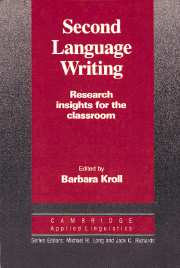Book contents
- Frontmatter
- Contents
- List of contributors
- Series editors' preface
- Preface
- Introduction
- I PHILOSOPHICAL UNDERPINNINGS OF SECOND LANGUAGE WRITING INSTRUCTION
- Chapter 1 Second language composition instruction: developments, issues, and directions in ESL
- Chapter 2 L1 composition theories: implications for developing theories of L2 composition
- Chapter 3 An overview of second language writing process research
- Chapter 4 Coaching from the margins: issues in written response
- Chapter 5 Second language writing: assessment issues
- Chapter 6 Reading–writing connections: toward a description for second language learners
- II CONSIDERATIONS FOR WRITING INSTRUCTION
- Index
Chapter 5 - Second language writing: assessment issues
Published online by Cambridge University Press: 05 October 2012
- Frontmatter
- Contents
- List of contributors
- Series editors' preface
- Preface
- Introduction
- I PHILOSOPHICAL UNDERPINNINGS OF SECOND LANGUAGE WRITING INSTRUCTION
- Chapter 1 Second language composition instruction: developments, issues, and directions in ESL
- Chapter 2 L1 composition theories: implications for developing theories of L2 composition
- Chapter 3 An overview of second language writing process research
- Chapter 4 Coaching from the margins: issues in written response
- Chapter 5 Second language writing: assessment issues
- Chapter 6 Reading–writing connections: toward a description for second language learners
- II CONSIDERATIONS FOR WRITING INSTRUCTION
- Index
Summary
The field of writing assessment has developed considerably in the last quarter of the century. Twenty years or so ago, many if not most people in North America (to a lesser extent in Great Britain and Australia) believed that writing could be validly tested by an indirect test of writing. As we enter the 1990s, however, they have not only been defeated but also chased from the battlefield. This change is the result of social pressure from schools, colleges, and parents, who argued that failure to learn and practice writing reasonable lengths of text in school was leading to declining literacy levels and to a college-entry population that could not think critically about intellectual ideas and academic material. In 1970 researchers had begun to respond to these social pressures, but there were serious questions about the levels of reliability that could be achieved on a direct test of writing (these same questions had been primarily responsible for the disfavor writing had fallen into as a test method from the 1940s on). What was happening in the field of writing assessment then was the kind of transatlantic conflict of philosophies that we have become familiar with in many areas of English as a second language (ESL) teaching. North American research emphasized the failure of direct writing tests to achieve score reliability levels that could compete with score reliabilities on multiple choice items, and many, perhaps even most people became convinced of the hopelessness of direct writing assessment.
- Type
- Chapter
- Information
- Second Language Writing (Cambridge Applied Linguistics)Research Insights for the Classroom, pp. 69 - 87Publisher: Cambridge University PressPrint publication year: 1990
- 62
- Cited by

